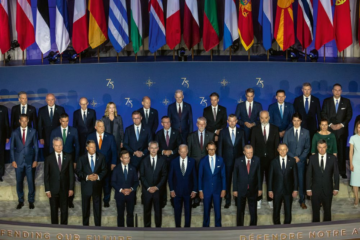Russian Foreign Minister Sergei Lavrov said about the Arctic Circle, “It has been absolutely clear for everyone for a long time that this is our territory.” He added, “This is our land and our waters.” Russia acts on those assertions today as rising sea temperatures strengthen its de facto economic and military control over the Arctic while threatening North Atlantic Treaty Organization (NATO) strategic stability.
Over 4,300 miles of Russia’s Siberian Plateau are undergoing renovation—including a floating nuclear power plant—to support new civilian settlements and 17 full-service Northern Sea Route (NSR) ports, tightening control over regional petroleum supplies and commerce through increased Russian military presence.
Oil and gas exports top Russia’s priorities, representing 60 percent of total revenue and 30 percent of the Russian government’s overall budget. Rising ocean temperatures are providing new access to minerals on land and sea. Multi-billion-dollar contracts with Gazprom, Rosneft, and Novatek will develop the Vostok oil field and Yamal Liquid Natural Gas plant. Once complete, these facilities could rival the Nord Stream Pipeline and increase Putin’s influence.
Russia possesses the largest icebreaking fleet—40 ships compared to the United States’ two—escorting the most maritime traffic through the NSR. Warming seas will likely increase demand for shippers seeking shorter transit times between the Atlantic and Pacific Oceans, while new ports will serve increased maritime traffic. Putin is also considering a Trans-Siberian Railway between seaports and an Arctic road that expedites cargo across Russia’s interior.
The Northern Fleet projects growth to 50 icebreaker vessels as part of its full-spectrum operations to “phase NATO out of the Arctic.” One year into the Ukraine war, Russian global positioning satellite (GPS) jamming incidents affecting foreign sea vessels in the NSR nearly doubled.
In 2022, Norway reported Russian intelligence gathering drones over its Svalbard archipelago and energy-processing facilities. Russia thinly veils this activity as responses to action against it in Ukraine and correlates operations between the two theaters.
The UN Convention on the Law of the Sea (UNCLOS) decrees Arctic Circle nations possess up to 200 nautical miles of contiguous seabed, extendable with supporting scientific data. In 2007, a Russian submarine planted a flag on the seabed beyond its border, claiming the Lomonosov Ridge and 1.2 million additional square kilometers of seabed, drawing Canada and Denmark into a legal battle over economic exclusion area infringement.
On December 5, 2022, Putin updated the “Rules of Navigation on the Water Area of the Northern Sea Route.” The revision now prohibits foreign military vessels in internal waters unless heading to port, re-designates the NSR straits as internal waters (instead of international routes), requires military vessels receive permission 90 days before passage, and allows only one warship at a time. Russia enforces its perceived territorial gains with bomber overflights of the NSR, citing security, but obfuscates where security ends and militarization begins.
Seven Arctic military locations anchor Russia’s Arctic military monopoly and are or have received upgrades to military capabilities. First, the Novaya Zemlya Archipelago is where Russia conducts nuclear testing. Intelligence suggests upgrades to facilities could mean atmospheric testing may resume. Second, the Nagurskoye Air Base is seeing a runway expansion, air defense missiles added, and a new meteorological facility completed. Third, Rogachevo Air Base is getting upgrades to radars, air defense missiles, electronic warfare capabilities, and signals intelligence assets. Third, Sredniy Air Base is receiving a runway expansion. Fourth, Northern Clover Base is receiving observation, air defense missile, and equipment-testing upgrades. Fifth, Wrangel Island’s deepwater port, radar station, air defense missiles, and signals intelligence collection, used to monitor American bases in Alaska, were all upgraded. Sixth, air defense missiles were emplaced at Cape Schmidt.
These Arctic military upgrades show Russia’s intent to monopolize Arctic commerce and create a new avenue of attack against NATO. Wrangel Island can house submarines and surface ships, establishing Arctic entry control between Russia and Alaska. Bases at Nagurskoye and Rogachevo establish similar control on the opposite end of the Arctic Ocean, creating guarded entry points supported by the new military installations along Russia’s Arctic coast.
Canada’s Arctic region directly across from Russia is mostly uninhabited but contains two Cold War–era early warning radar sites supporting NATO. In 2022, then Canadian Chief of Defense Staff Wayne Eyre called the Arctic “a key area of concern,” warning North America’s Arctic coast may be vulnerable and prompting joint exercises focused on northern nuclear attacks. Exercises Joint Viking and Joint Warrior included new members Sweden and Finland but do not match Russia’s increased regional presence.
America’s early warning facility at Thule, Greenland, is crumbling from under-investment and melting permafrost, while the Danish government monitors over 400 Russian infrastructure projects. China envisions itself a near-Arctic country under its Belt and Road Initiative and acquired a decommissioned Russian military facility. Rather than pursue a large footprint, China bankrolls many of the ongoing Russian projects. The Danes warn Chinese ownership of Arctic facilities can create safe havens for Russian forces and bring both adversaries to NATO’s polar doorstep.
The once-isolated Arctic Ocean is bustling with Russian activity as former Russian Premiere Mikhail Gorbachev’s proclaimed “zone of peace” becomes militarily contested. Russia continues its brand of strong-arm diplomacy using military force as an enabler for commercial expansion and financial gain.
NATO must prepare for what a Russian Arctic Ocean monopoly could mean for international commerce and security. Simply admiring the problem is no longer an option. Deterring Russian aggression means the United States and its NATO allies must expand their own capability to levels that dissuade Russian action.
Dan Wasserman is a contributor to Global Security Review. The views expressed are his own.




